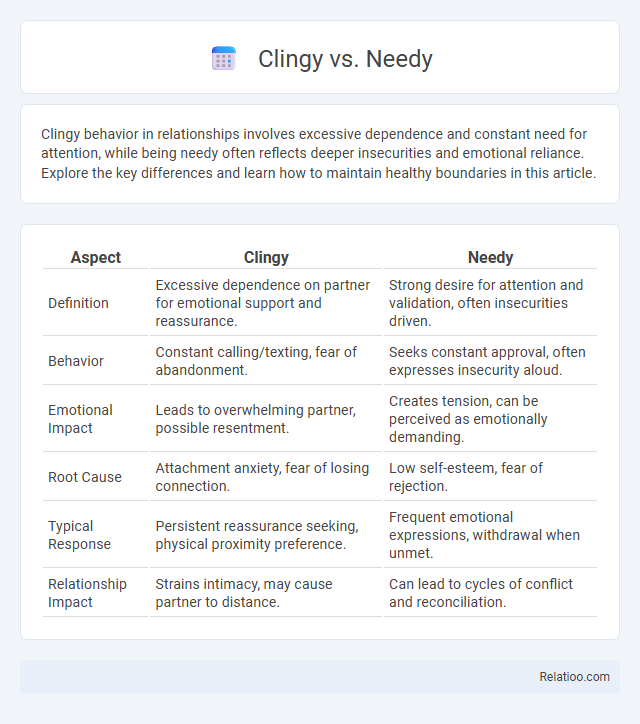Clingy behavior in relationships involves excessive dependence and constant need for attention, while being needy often reflects deeper insecurities and emotional reliance. Explore the key differences and learn how to maintain healthy boundaries in this article.
Table of Comparison
| Aspect | Clingy | Needy |
|---|---|---|
| Definition | Excessive dependence on partner for emotional support and reassurance. | Strong desire for attention and validation, often insecurities driven. |
| Behavior | Constant calling/texting, fear of abandonment. | Seeks constant approval, often expresses insecurity aloud. |
| Emotional Impact | Leads to overwhelming partner, possible resentment. | Creates tension, can be perceived as emotionally demanding. |
| Root Cause | Attachment anxiety, fear of losing connection. | Low self-esteem, fear of rejection. |
| Typical Response | Persistent reassurance seeking, physical proximity preference. | Frequent emotional expressions, withdrawal when unmet. |
| Relationship Impact | Strains intimacy, may cause partner to distance. | Can lead to cycles of conflict and reconciliation. |
Understanding Clingy vs Needy: Key Differences
Understanding the key differences between clingy and needy behavior helps you manage relationships more effectively by recognizing emotional dependence versus excessive attachment. Clingy individuals often seek constant physical or emotional proximity, while needy individuals require excessive reassurance and validation to feel secure. Distinguishing clinginess from neediness involves analyzing underlying motivations and emotional needs to foster healthier connections.
Defining Clingy Behavior in Relationships
Clingy behavior in relationships is characterized by excessive dependence, constant need for reassurance, and an overwhelming desire for closeness that can stifle personal space. Unlike needy behavior, which often stems from insecurity and low self-esteem, clinginess manifests through persistent attachment and frequent demands for attention. Understanding clinginess helps partners identify boundaries and maintain a healthy balance between intimacy and independence.
What Does It Mean to Be Needy?
Being needy means seeking excessive attention, reassurance, and validation from others, which stems from insecurity or fear of abandonment. Your emotional dependency can cause strain on relationships as you constantly require support and affirmation to feel secure. Understanding the difference between clingy and needy behaviors helps you manage your needs more healthily and maintain balanced connections.
Emotional Roots: Why People Become Clingy or Needy
Emotional roots of clinginess and neediness often stem from unresolved attachment issues, low self-esteem, and fear of abandonment. Individuals exhibiting clingy behaviors typically seek constant reassurance and emotional security to alleviate deep-seated anxiety or past trauma. Understanding these psychological triggers reveals why clinginess and neediness manifest as coping mechanisms to fulfill unmet emotional needs.
Signs You’re Clingy vs Signs You’re Needy
Signs you're clingy include frequently seeking constant physical or emotional closeness and having difficulty spending time apart from your partner, while signs you're needy involve excessive reassurance-seeking and a deep fear of abandonment that drives your behavior. Clinginess often manifests as a desire for immediate attention and physical presence, whereas neediness stems from insecurity and dependence on others for self-worth. Understanding these distinctions helps you identify whether your attachment style is rooted more in affection or anxiety, allowing you to improve your relationships effectively.
Impact of Clingy and Needy Behavior on Relationships
Clingy and needy behavior often lead to emotional strain, creating imbalance and tension within relationships. Your constant need for reassurance or excessive dependence can cause your partner to feel overwhelmed or suffocated, potentially resulting in decreased intimacy and trust. Recognizing and addressing clinginess is crucial for maintaining healthy boundaries and fostering mutual respect.
Healthy Attachment vs Unhealthy Dependence
Clinginess often reflects a healthy attachment style where You seek comfort and connection without overwhelming others, while neediness indicates unhealthy dependence marked by excessive emotional reliance and insecurity. Distinguishing between the two involves recognizing when attachment fosters mutual support versus when it leads to control or anxiety. Healthy attachment promotes trust and independence, whereas unhealthy dependence undermines personal boundaries and emotional well-being.
Setting Boundaries with Clingy and Needy Partners
Setting boundaries with clingy and needy partners involves clearly communicating personal limits to maintain emotional balance and independence. Recognizing clinginess as excessive attachment and neediness as emotional dependence helps tailor strategies for respect and space. Establishing consistent boundaries fosters healthier relationships by preventing codependency and promoting mutual understanding.
Strategies to Overcome Clinginess and Neediness
Overcoming clinginess and neediness requires cultivating self-confidence and establishing healthy boundaries to foster emotional independence. Practicing mindfulness techniques and engaging in hobbies can reduce excessive reliance on others for validation, promoting balanced relationships. Seeking professional counseling or support groups can provide personalized strategies to address underlying insecurities contributing to clingy or needy behavior.
Building Secure and Independent Relationships
Clingy behavior often reflects an intense desire for constant reassurance, while neediness stems from deeper insecurities that hinder self-sufficiency, both impacting relationship dynamics negatively. Building secure and independent relationships requires fostering self-confidence, setting healthy boundaries, and encouraging mutual trust to prevent emotional dependency. Prioritizing open communication and personal growth strengthens bonds by promoting emotional autonomy and reducing clinginess.

Infographic: Clingy vs Needy
 relatioo.com
relatioo.com